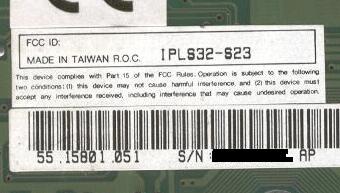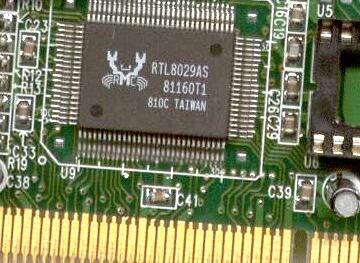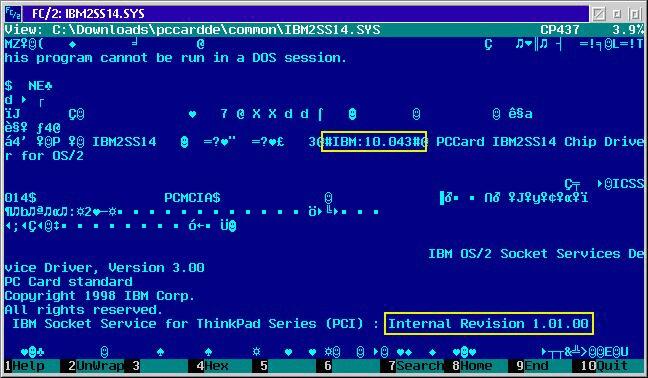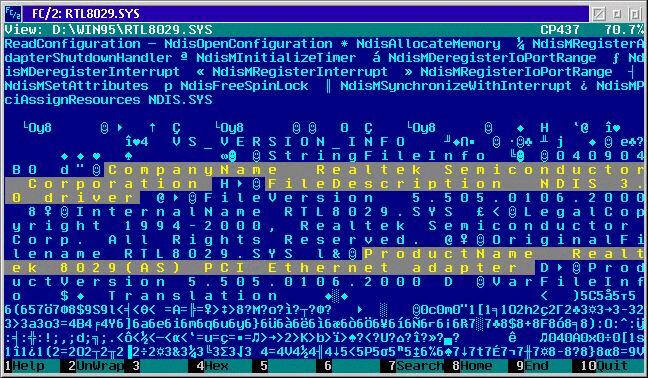
VOICE Home Page: http://www.os2voice.org
[Newsletter Index]
[Previous Page] [Next Page]
[Feature Index]

VOICE Home Page: http://www.os2voice.org |
April 2002
[Newsletter Index]
|
| By Thomas Klein © April 2002 |
Recently I read a tip (in the Voice newsletter I guess) about how to search for
drivers or hardware information using the device's FCC-ID. This quite surprised
me, as I thought that almost everybody knew about this way. In my mind this is one
more indication that there is a need for the OS/2 community to have either a tight
network and/or a central access point regarding tips, tricks or experiences. Well,
I am certain that WarpDoctor will profoundly change that situation.
But besides that - what can you do to get specific information or drivers for
a given piece of hardware? Because of the constant changing of the internet (which
not always equals an improvement) it might be clear that all possible ways I'm going
to shop up here might be vanished in less than some months. There is no common method
that will always help you succeed - your mileage may vary. What I am about to explain
is more or less "my way", point you to several starting points which might
serve you in proceeding. It consist merely of two steps:
Anyway - now all you need is the FCC's web site to type in the ID (or maybe just
the grantee code), right? Here we go: http://www.fcc.gov/oet/fccid/
...and if you're lucky, you'll get to know who the heck built that device. Notice
that the FCC-ID is only given to products which are intended to be sold in the U.S.
market.

Fig.1: Example of an FCC-ID
The FCC-ID shown above was found on an adapter that was lying around for quite
a while in my spare parts box. If you go on and check it on the FCC site, you'll
quickly find out, that it's a sound card from AESL Technology INC. But unfortunately
it won't help you in any way, as there's no site for such manufacturer (at least
as far as I could see in preparation of this article). But if you would have that
adapter right in front of you, you would have already discovered that according
to what's stamped on its front, it's a "Philips PCA70 PS" and that it
shows a Crystal Semiconductor "CS4238" chip. In this case, you wouldn't
even had to rely on the FCC database (we'll get back to that later) but no matter
- I just wanted to give you an example of what a FCC-ID looks like. To sum it up:
If there's an FCC-ID it will give you a good start...
Most adapters (sound, graphics, network, controller) are basically made of a
pcb layer (the "card"), some elements for electrical supply and control,
some others for signal preprocessing, maybe a clock generator (quartz) and finally...
the processor that does the "actual work". And *that's* your enemy's weak
point! ;) No company that wants to sell competitive low-priced stuff and keep up
with today's fast-path product cycles can afford to re-invent everything again and
again. Instead, they simply buy parts from specialized manufacturers and simply
sold them altogether onto a board (example: Philips sound card from AESL with Crystal
chipset...), drop a generic driver disk with it into a box, shrink wrap it and that's
it. Most of the time, they don't even care of putting their company's name in the
according files on that driver disk.
As an example, let's figure out what happened to "RTL8029", a network
adapter chipset found on many low-priced Ethernet controller cards: There are about
3 or more companies that provide a set of drivers for their adapter which uses this
chipset. If you take a short look at the files, you'll discover that each of them
states "Realtek", who is the actual maker of the chipset. Well, we all
have to save time and money wherever we can... So don't worry, but stay optimistic!
Usually on earth, it's just 3 different actual manufacturers of chips that are designed
to serve the same purpose (e.g. ethernet controller) but who are not compatible.

Fig.2: Sample chipset
Fine - all you need to run that thing you found at your in-law's garage sale,
is a driver for OS/2? Let's simply start like that:
Just type "+rtl8029as +os/2" at yahoo!
...and the first out of 75 matches is a 100% direct hit which will lead you to
Realtek's "products" site, providing a link to the manufacturer's download
page... wow, what a fortunate coincidence... and what a bad example as well ;) Okay,
to show you what to do if things turn out bad, let's just get on and assume that
your search did not give you any (usable) results. At this point usually you're
stuck... unless you know about a chip's life cycles: Chips are being designed once,
then they are revised or improved and usually they should carry some kind of revision
suffix in their names. In case of our example this would mean, that the predecessor
of RTL8029AS probably was called RTL8029 and has undergone some kind of revision
which gave him that "AS" suffix. Okay, yes, this is a quite abstract way
of thinking, but if you're stuck in the middle of nowhere, you're thankful for every
little bit of help, aren't you? In addition, you probably do have a chip named "RTL8029"
built on your adapter card and after all: I need a new example. ;)
So let's assume you're starting from scratch with "+rtl8029 +os/2"
entered as your Yahoo! search term.
After checking the first 10 matches, you're likely to know that the manufacturer
seems to be REALTEK, as this name is contained in most of the link descriptions.
So we're back: Knowing the manufacturer (either thanks to a FCC-ID or by searching
for additional information). If Yahoo! (or Google respectively) didn't give you
enough matches try it again by removing "+OS/2" from the search term.
This is intended to look for things like hardware reviews or how-to's in addition
and might too much narrow down the matches found.
One more thing, before we go on: Don't let the net get you down - persevere with
your investigations. Sooner or later you'll find a document or two that will let
you proceed one more step. I once had a set of ISA network cards with BNC cable
and terminators from a friend of mine. He bought the stuff from a company that was
about to be liquidated and planned to set up his home network,first, but then decided
to not do it for some reason. As I once helped him with some kind of hardware problem,
he asked me whether I could use it and gave me the stuff for free, just to get rid
of it. I was faced with the problem of not having either manuals or driver disks.
After a long time of searching in vain I found some web page that was entirely in
chinese and appeared to be excerpts of discussion threads. I used ctrl-f to look
for the string "MX" that I had entered at Yahoo! (altogether with "network
adapter"). I can't exactly remember anymore, but I guess it was due to a hyperlink
"close" to that string, that I finally found the manufacturer's web site
for "retired products". The URL that is associated with such hyperlink
is resolved in "non-chinese": Moving your mouse pointer to the hyperlink
will resolve the URL in your browser's status area, even if the link text is in
chinese... yeah, I know this is nothing tremendously new and that you probably knew
it yet, but I just wanted to tell it once again, as people tend to forget such things...
this could help you in checking out if there is some kind of driver page available.
Did I mention that it works well on cyrillic pages too? ;)
But let's get back to what I mentioned before about searching another manufacturer...
how are we supposed to find it? Simply by searching once more.;) In the above example
of RTL8029, we know that we're dealing with a network adapter card, and that it's
a pci bus model. So here we go again at Yahoo!: "+pci +network +adapter
+rtl8029" ...and almost after the first page of matches, you'll find Kingston,
OvisLink and SVCE are worth dropping by. (I never heard of SVCE before). When browsing
the pages found, you should always try to look for links or headlines like "PCI
Network Adapter". Or "8029" as most of the manufacturers adopt it
to make up their product and model names. Thanks, folks! This way, you should easily
identify a compatible model from a different manufacturer, enabling you to look
for appropriate drivers. None of the three manufacturers named above explicitly
states "drivers for OS/2" anywhere, but at least Kingston and Ovislink
provided the entire driver sets from Realtek (the manufacturer of the RTL8029 chip),
including NDIS2 drivers for OS/2. The only drawback here is that they come as self-extracting
archives for Windows. But even that shouldn't be a problem: They consist of a program
header part, the zip data stream (containing the packed files) and the central zip
directory. Just like "normal" zip files do. To give you an impression
of what I'm talking about just try renaming the .exe to .zip for fun and pop it
into your favorite unzip application. I used FC/2 and had no problems to access
the files contained in it or view the readme for example.
Probably there's another hint applicable, if we're dealing with "genuine"
hardware that comes with a proprietary, non-generic driver: Check to see what chipset
is used on/in the device and if there maybe is a generic driver for it. Like I mentioned
in my review on the DawiControl
SCSI controller, this might save your day. The manufacturer's device driver
caused severe problems when used in conjunction with specific fixpak levels. But
as the controller's chip was a Symbios SYM53C875 (yes, they're called "LSI
Logic" now), I tried to use Symbios' drivers instead... and surprise: Everything
worked like a charm.

Fig.3: Looking into an OS/2 driver file
So if your strange part of hardware only comes with a windows driver disk and
you don't know the manufacturer, model nor FCC-ID, there is no chip with an useful
name and the readme file only explains how to install drivers under windows 95...
don't worry - there's still a chance of finding information! Grab that windows driver
and load it into you editor. Jump to the end of the file, then scroll backwards
line per line.

Fig.4: Looking into a Windows driver file
This way you'll probably get to know some more information on manufacturer or
model of that strange piece of hardware of yours. If you intend to do text search
within the file please be aware that these "clear text" looking parts
of windows drivers most likely are made of unicode characters: Each character is
stored using two bytes, thus "Copyright" being stored as "C o p y
r i g h t" for example, with the "space" signs being binary zeroes
that you won't be able to enter in your search dialog. So, if your editor only supports
ASCII ("usual" text) search, you won't find the strings.
But in fact, there is no such great difference to what I mentioned above: Again,
use the appropriate window's driver file and your editor to find out what you're
dealing with, then check for drivers. You can even take a look at what's contained
in the window's .INF files. Simply check either the commentary at the top of the
file (if there is one) or entries like "DeviceDesc=..." or "Manufacturer=...".
Then, check any readme's or - as described above - driver files themselves. To conclude
this tour on mobile computing, there is one website you should make sure to rely
on: Dr. Martinus Notebook/2
site! Whenever it's about notebooks and OS/2, this is a real "must have"
web page. It provides all relevant information to more than 300 models - exclusively
for OS/2 - grouped by manufacturers and models. There is also a wealth of information
on drivers and pc-cards (pcmcia). You probably won't find the latest and hottest
"killer models" there, but in case of planning to buy a cheap, used notebook
and looking for usability information prior to your acquisition, I urge you to take
a look.
If you need basic information prior to new acquisitions (like "What graphic
card should I choose?"), you're welcome to post it in yahoo!s OS/2
Hardware group". As it is quite rare that I visit newsgroups, I didn't
want to praise them here too much, as I can't tell you a lot about it anyway...
but you're always welcome to create your own experience - go ahead and try.
WarpDoctor and the hardware compatibility
list are needed more than ever, and I'm sure they can live up to our expectations.
At least, I'll drop every little bit of information I've got into those two databases
(WD and HCL) as soon as they're on air - that's for certain. And I urge you, users,
readers and writers of hardware and software reviews to not keep your experiences
(whether good or bad) hidden somewhere, no matter how recent or old they are - share
them with us and feed these new "babies".
Thomas Klein is an IT consultant at Systor GmbH & Co. KG and is currently involved in software quality control in a large-scale project at IBM. He's been using OS/2 since version 2.11
[Feature Index]
editor@os2voice.org
[Previous Page] [Newsletter Index] [Next Page]
VOICE Home Page: http://www.os2voice.org